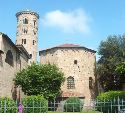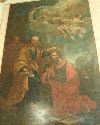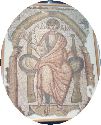
(40K)
648 x 432
|
Arriving at Ravenna, Capital of the Western Roman Empire, influenced by Theodoric and the Eastern Empire in the 5th to 8th centuries. Here the city center at Piazza del Popolo, with the Palazzo Comunale (City Hall). The statue on the left column is St. Apollinare, on the right St. Vitalis.
|

(46K)
450 x 672
|
The tomb of the "Divine Poet" Dante (1265-1321) , who wrote the Divine Comedy, which made him the father of the modern Italian language. Exiled from Florence, he lived in Ravenna the last 3 years of his life.
|

(38K)
672 x 450
|
The Cathedral (blocked by trees), was built in the 5th century, then torn down and replace by this one from the 18th century.
|

(61K)
450 x 672
|
Interior of the Cathedral.
|

(60K)
450 x 672
|
The Eucharistic altar in the Cathedral, with an appropriate painting of Moses and the people gathering the Manna.
|

(56K)
672 x 450
|
Tomb in the Cathedral.
|

(47K)
450 x 672
|
Incredible stone pulpit in the Cathedral.
|

(58K)
450 x 672
|
Walking to the Basilica of St. Vitalus. One guidebook calls it "the most important monument of early Christian art in Italy." It is definately a magnificent work of Byzantine architecture and mosaic.
|

(35K)
450 x 672
|
The Basilica is built on the place of the martyrdom of St. Vitalis, a husband and father who was racked and then buried alive in the Roman persecutions, possibly around 171 A.D. Here inside the cloister.
|

(58K)
672 x 450
|
San Vitale basilica, built in 541-546, and the mosaics were made under the authority of Justinian, who took the city in 540. Artisans from Constantinople may have had a hand in the mosaic work. The eastern influence is seen by the octagonal plan surmounted by a large cupola.
|

(55K)
450 x 672
|
Inside the Basilica, one's eyes are drawn upward, especially to the extraordinary mosaics from the 5th century.
|

(60K)
672 x 450
|
Apse mosaic of Christ as cosmocrator [ruler of the wolrd] sits on the sphere of the cosmos. Saints, including Saint Vitalis and Archbishop Ecclesius and a donor are being welcomed into the celestial garden of Paradise. Beneath flow the four rivers of Paradise, which become part of standard iconography.
|

(74K)
450 x 672
|
Detail of mosaics of the 12 Apostles and Christ in the archway. Behind, in the middle of presbyterium dome, a mosaic of the "tent of heaven." Parying angels support the Lamb Triumphant surrounded by garland of four seasons which suggests Paradise.
|

(68K)
450 x 672
|
With almost every vault and even pillars decorated, the choir is filled with a mosaic carpet of expressive colors.
|

(55K)
450 x 672
|
The cupola of the Basilica. Due to the difficulty of photographing St. Vitalis, one loses the perspective of the large size.
|

(44K)
648 x 432
|
Masoleum of Galla Placidia - daugher, sister, wife and mother of emperors, she reigned the Western Roman Empire and had this 5th century masoleum built.
|

(83K)
672 x 450
|
Note the deep blue of the countless stars, and the apostles appearing like Roman Senators.
|

(60K)
672 x 450
|
Mosaic of Christ the good shepher inside the masoleum.
|

(51K)
450 x 672
|
Passing by a quaint little Church dedicated to St. Euphemia: a 15 year old girl martyred in 304, in Calcedon near Constantinople. It is also where a recent important archeological find of a Byzantine palace, 10 feet below ground, filled with 6th century mosaic flooring. Now called the "House of the Stone Carpets."
|

(57K)
522 x 473
|
The Neonian Baptisty next to the Cathedral (called Orthodox as opposted to the heretical Arian Baptistry). This is the oldest monument in Ravenna, which dates to the end of the 4th century.
|

(90K)
672 x 450
|
Interior dome of the baptistry decorated with bright mosaics.
|

(60K)
672 x 450
|
The large octagonal baptism font, with built in pulpit that was used during the baptisms.
|

(44K)
672 x 450
|
A side view of the Cathedral, which also holds a small museum and the Archbishop's chapel.
|

(55K)
432 x 648
|
In the museum: the Virgin Mary in prayer.
|

(57K)
461 x 576
|
Painting depicting St. Peter sending St. Apollinare to Ravenna (the building in the background is the Masoleum of Theodoric. One of the first great martyrs of the church. tradition says Apollinare was made Bishop of Ravenna by St. Peter himself.
|

(52K)
468 x 576
|
Mosaic of Adam giving a blessing (in another museum).
|

(78K)
672 x 450
|
It is said there are more bycicles than cars in Ravenna, which I believe. It was a wonderful city for walking and riding.
|

(34K)
450 x 672
|
Church of St. Francis in Ravenna.
|

(30K)
450 x 672
|
Basilica of Sant'Apollinare Nuovo. Build in the 6th century for Theodoric, whose mosaics cover the largest surface area of any in the city. Hardly "new", it is called the "New Basilica" to distinguish it from two others nearby.
|

(65K)
672 x 450
|
The nave of the Basilica consists of a long procession of Virgins on the left and Martyrs on the Right.
|

(64K)
672 x 450
|
Detail of the procession of virgins. These mosaics are one of the most typical examples of teh Byzantine style present in Ravenna, and are famous throughout the world.
|

(60K)
672 x 450
|
The goal of the long procession is the heavenly court, here Mary and Jesus surrounded by angels.
|

(42K)
672 x 450
|
Right: the Baptistry of the Arians, built around the end of the 5th century, when Theodoric ruled and Arianism was the official religion.
Left: The Church of the Holy Spirit, also built by the Arians, now used by the Orthodox.
|

(90K)
672 x 450
|
Inside the Arian Baptistry, with its dome mosaic depicting the baptism of Christ and the 12 apostles. According to Arian heresy, Christ was a human, adopted as the Son of God, but not fully divine and equal to the Father.
|

(34K)
432 x 648
|
Basilica of St. John the Evangelist, which dates from the 5th century.
|

(56K)
432 x 648
|
Detail of the portal leading to St. John the Evagelist, the church
|

(49K)
672 x 450
|
The interior is quite plain, but is paticularly known for its columns, and the equisite capitals on the top of each.
|

(43K)
648 x 432
|
View from the train of the town of Godo, Italy. I believe it is the Church of St. Stephen.
|





































